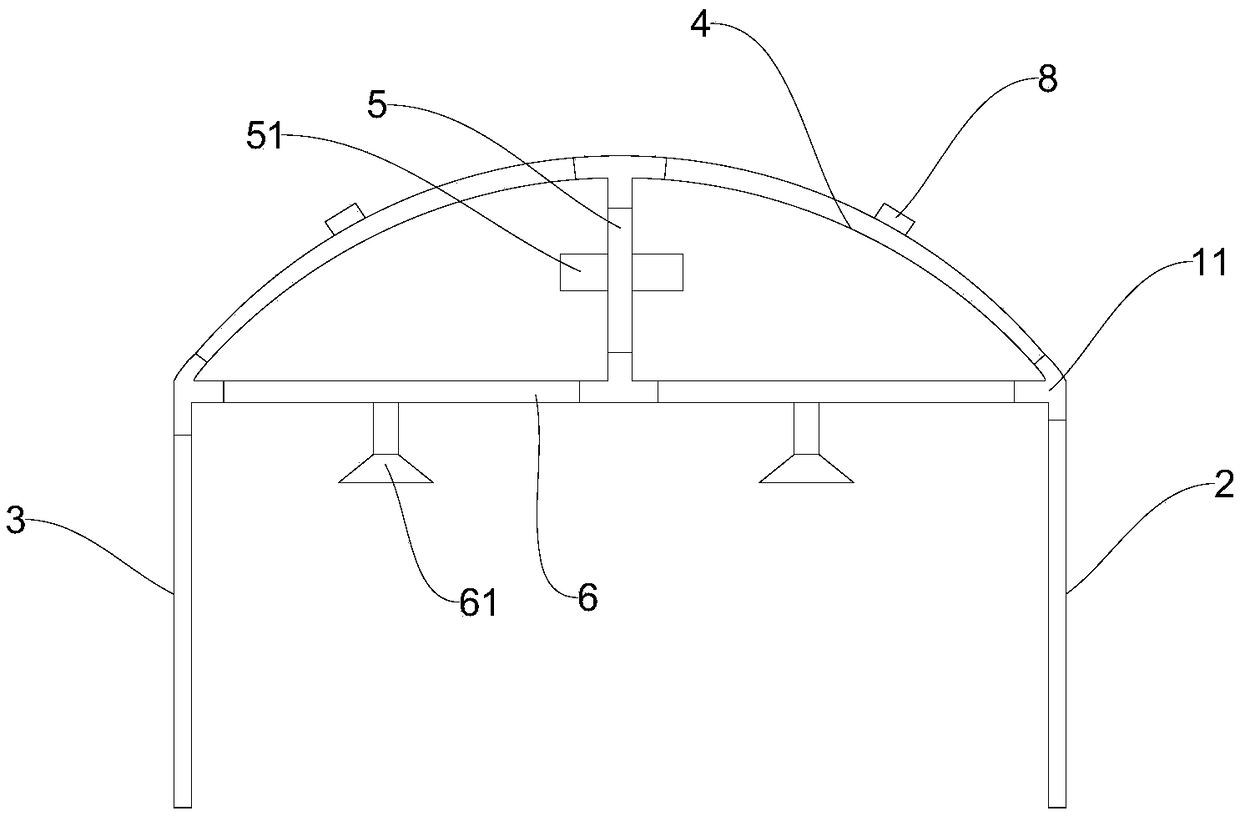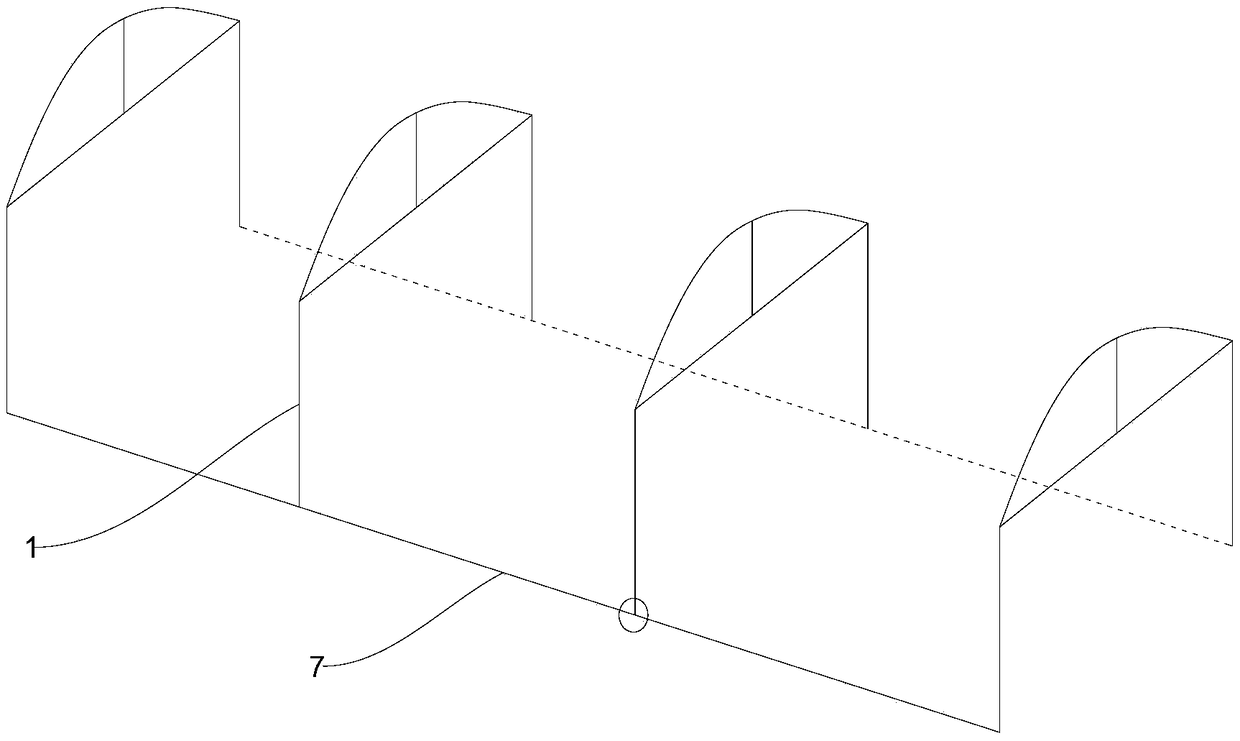Interplanting method of tomatoes and pakchoi
A technology of cabbage and tomato, applied in the direction of soil preparation method, fertilization method, botanical equipment and method, etc., can solve the problems of destroying soil ecological structure, low land utilization rate, environmental pollution, etc., and achieve improvement of soil fertilizer efficiency and excellent adsorption The ability of heavy metals, the effect of cost reduction
- Summary
- Abstract
- Description
- Claims
- Application Information
AI Technical Summary
Problems solved by technology
Method used
Image
Examples
Embodiment 1
[0034] A method for interplanting tomato and Chinese cabbage, comprising the following steps:
[0035] S1: Build a special greenhouse, such as Figure 1-3As shown, the special-purpose greenhouse includes a ground fixing frame 7, several skeletons 1 and a shed film, and the ground fixing frame 7 is a slide bar structure placed on the ground; each of the skeletons 1 includes a first support foot 2, a second support Foot 3, arc-shaped top frame 4, transverse connecting rod 6 and longitudinal connecting rod 5; the ends of the transverse connecting rod 5 are fixedly connected to the arc-shaped top frame 4, and the two ends of the arc-shaped top frame 6 are fixedly connected respectively The first supporting foot 2 and the second supporting foot 3, the longitudinal connecting rod 5 fixedly connects the highest point of the arc top frame 4 and the midpoint of the transverse connecting rod 6; the first supporting foot 2 , the second support foot 3, the arc-shaped top frame 4, the but...
Embodiment 2
[0048] A method for interplanting tomato and Chinese cabbage, comprising the following steps:
[0049] S1: Build a special greenhouse, the same as in Example 1; the roof of the shed is covered with a permeable film in winter, and the roof of the shed is covered with a black film in summer. The temperature in the shed is kept at 23-28°C during the day, and the humidity is controlled at 70%-80%. The height of the shed is 90~100cm, width 1.4~1.6m;
[0050] S2: Before sowing, apply basal fertilizer to the soil and plow 15 to 20 cm, and open a furrow with a width of 20 to 25 cm at a distance of 20 to 25 cm from the edge of the shed;
[0051] The base fertilizer is prepared from the following raw materials: compound bacterial liquid, bagasse, biogas residue, and organic manure are used after mixing according to the weight ratio of 0.05:15:15:25; the usage amount is 900kg / mu;
[0052] The composite bacterial liquid is prepared by mixing Trichoderma viride, Actinomycetes, Bacillus li...
Embodiment 3
[0059] A method for interplanting tomato and Chinese cabbage, comprising the following steps:
[0060] S1: Build a special greenhouse, the same as in Example 1; the roof of the shed is covered with a permeable film in winter, and the roof of the shed is covered with a black film in summer. The temperature in the shed is kept at 23-28°C during the day, and the humidity is controlled at 70%-80%. The height of the shed is 90~100cm, width 1.4~1.6m;
[0061] S2: Before sowing, apply basal fertilizer to the soil and plow 15 to 20 cm, and open a furrow with a width of 20 to 25 cm at a distance of 20 to 25 cm from the edge of the shed;
[0062] The base fertilizer is prepared from the following raw materials: compound bacterial liquid, bagasse, biogas residue, and organic manure are used after mixing according to the weight ratio of 0.03:12:13:22; the usage amount is 850kg / mu;
[0063] The composite bacteria liquid is prepared by mixing Trichoderma viride, Actinomycetes, Bacillus lic...
PUM
| Property | Measurement | Unit |
|---|---|---|
| Height | aaaaa | aaaaa |
| Length | aaaaa | aaaaa |
| Height | aaaaa | aaaaa |
Abstract
Description
Claims
Application Information
 Login to View More
Login to View More - R&D
- Intellectual Property
- Life Sciences
- Materials
- Tech Scout
- Unparalleled Data Quality
- Higher Quality Content
- 60% Fewer Hallucinations
Browse by: Latest US Patents, China's latest patents, Technical Efficacy Thesaurus, Application Domain, Technology Topic, Popular Technical Reports.
© 2025 PatSnap. All rights reserved.Legal|Privacy policy|Modern Slavery Act Transparency Statement|Sitemap|About US| Contact US: help@patsnap.com



